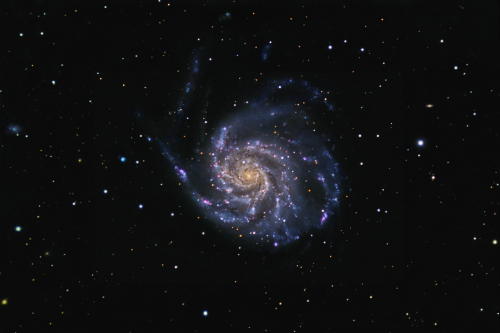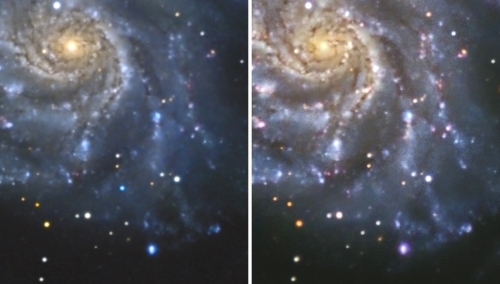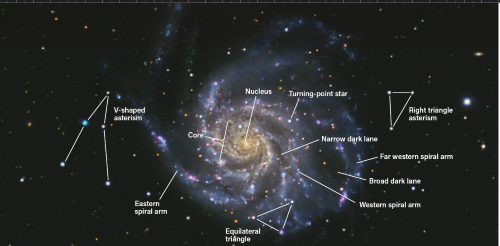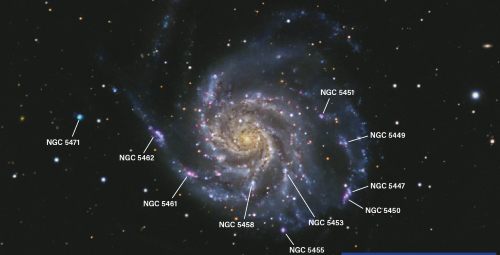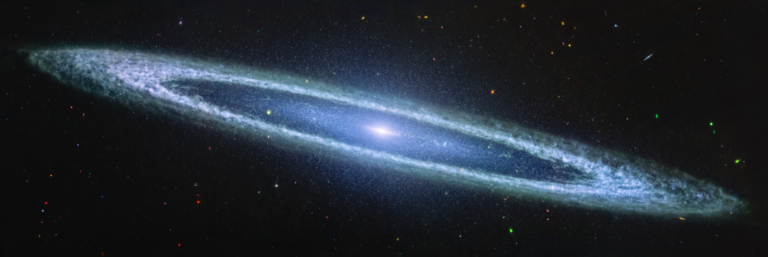As you might imagine, two galaxies with the same nickname have many similarities. Both are Hubble Type Sc galaxies with small central hubs and open spiral arms. Both present us with nearly face-on views. And both appear quite large in the sky. M33 has an apparent size of 67′ by 42′, so it covers 3.7 times the area of the Full Moon. M101 has a smaller apparent size of 30′ by 27′ — but that’s still as big as the Full Moon! For deep-sky observers, the most unfortunate similarity is that both galaxies appear quite dim in the eyepiece. While M33 is listed at magnitude 5.7 and M101 is not far behind at magnitude 7.8, spreading the galaxies’ light over their respective large surface areas renders them dim indeed. In fact, it’s easy for first-time observers to pass right over these galaxies without seeing them because they are so much larger and dimmer than expected.
Perhaps the most exciting similarity between the Pinwheels is that they both offer rare opportunities to observe deep-sky objects within another galaxy. We naturally think of any galaxy as a single deep-sky object, but not so with the Pinwheels. As I wrote in the November 2014 issue of Astronomy, M33 contains four nebulae bright enough to have their own NGC numbers. And M101 contains 11 nebulae bright enough to have their own NGC numbers — more than any other galaxy.
The most likely reason for M101’s record number of NGC objects is that astronomers believe M101 has undergone tidal interactions with dwarf galaxies in its group. The dwarf galaxy NGC 5477 is the leading suspect. Computer simulations of a close interaction between such a dwarf and a classic spiral galaxy generate a good approximation of M101’s appearance with a decidedly off-center core and far-flung spiral arms.
The NGC objects within M101 aren’t easy prey, though. Observing them requires adequate aperture, dark skies, patience, and detailed maps. But finding them is well worth the effort. Locating faint NGC objects in our own Milky Way Galaxy is rewarding, but spotting them in a galaxy 21 million light-years away is a fantastic experience.
Being prepared will increase your chances of success. Before going out, study maps and images to acquaint yourself with foreground stars and M101’s structures, including its spiral arms, and the relative positions of the NGC objects within them. After you have set up your telescope under dark skies, allow plenty of time for your eyes to fully dark adapt and protect your night vision by using a dim red flashlight to refer to the maps. Bring a variety of eyepieces.
Start with a low-power, wide-field ocular to familiarize yourself with the general layout of the Northern Pinwheel. If you identify the specific location of a target object but don’t see it, try zooming in with a higher-power eyepiece. High-power eyepieces will darken the background and increase contrast, which can be essential for separating one of these NGC objects from the diffuse glow of their surrounding spiral arms. Using averted vision (glancing a bit off to the side of the area upon which you are concentrating) also may help you to spot some of the objects. However, I have not found that nebula filters noticeably help.
The big picture
Through a low-power, wide-field eyepiece, M101 presents itself as a large, faintly glowing circular area with a slightly brighter round core punctuated at its center by a small, nonstellar nucleus. Persistent scrutiny will reveal multiple spiral arms curving outward from the central core. I’ll refer to the three arms in which we will hunt for nebulae as eastern, western, and far western, based on where they lie relative to the core. Be aware that even experienced deep-sky observers can find it challenging to decipher the patterns of M101’s faint spiral arms.
The western arm begins near a foreground star on the north side of the core and heads west toward another foreground star (turning-point star) where it abruptly turns south and then fans out. A broad dark lane separates it from the terminal portion of the far western arm and a narrow dark lane separates it from the eastern arm.
That nebula is enormous!
We’ll begin with M101’s easiest nebula, which actually lies well outside the visible galaxy. To the east of M101, just past the tip of the eastern arm, is a V-shaped asterism of five “stars,” with the vertex pointing north. Careful scrutiny will reveal that the middle star on the east side of the V isn’t a star at all (though I’ve seen more than one sketch of M101 where it is depicted as if it is). Rather, it’s a circular fuzzy spot with a bright center. You’ve found the giant nebula NGC 5471.
NGC 5471 is a massive HII region actively forming hot, blue stars, which explains why a good portion of it appears intensely blue in images. Hubble images and stellar photometry indicate that it is approximately 200 times the size of the Orion Nebula and has been forming massive stars for at least 100 million years. Such stars live fast and die young within a few million years as type II supernovae. Observations by the orbiting Chandra X-ray Observatory show three bright X-ray sources within NGC 5471 consistent with supernova remnants. NGC 5471 can be spotted with a 6-inch scope.
Nebulae in the eastern spiral arm
Scan westward from NGC 5471 to the tapered tip of the eastern spiral arm. Near the tip, you’ll find an elongated, brighter region oriented from northeast to southwest. This is NGC 5462, which William Herschel first noted. Astroimages show many hot, blue giant stars mixed among hydrogen-alpha nebulosity. In September 1951, the type II supernova SN1951H appeared near the optical center of NGC 5462. The supernova reached magnitude 17.5. NGC 5462 is visible through an 8-inch scope.
Traveling farther inward along the eastern spiral arm, you’ll come to another bright region located southeast of the core. This is the HII region NGC 5461. It resembles a faint, fuzzy star, like a dimmer version of NGC 5471. It also can be spotted with an 8-inch scope. If you have at least a 10-inch scope, then continue tracing the eastern spiral arm inward to where it joins the core. There you may find a small, dimly glowing patch of light, which is NGC 5458. Images show this nebula contains many blue giant stars.
The western spiral arm
If you have at least a 12-inch scope, trace the western arm outward from where it abruptly turns south; about 3.3′ southwest of the galaxy’s nucleus, you’ll find a small bright area hugging the edge of the narrow dark lane. This is NGC 5453. Continue to follow the western arm south and you’ll find a triangle of “stars” framing the area where it fans out and vanishes. Again, I’ve seen more than one sketch depicting all three points of this triangle as foreground stars, but the southernmost point is not a star — careful examination shows it has soft edges. This is the nebula NGC 5455. This HII region is where the type II supernova 1970G appeared in July 1970, reaching magnitude 11.5. The remnant of this supernova has since been observed by Chandra as a bright, compact X-ray source. Brighter than NGC 5453, NGC 5455 can be seen with an 8-inch scope.
Type II supernovae — explosions of single, massive stars — are strongly associated with HII regions of galaxies, where such stars are born. By contrast, type Ia supernovae, which occur when a white dwarf in a binary system gravitationally siphons enough gas off its companion to explode, are not necessarily associated with HII regions. On August 24, 2011, the type Ia supernova 2011fe (originally designated PTF11kly because it was detected by the Palomar Transient Factory) appeared within this spiral arm of M101 and was visible in amateur scopes. You can see SN2011fe as a bright blue star within the western spiral arm in the image of M101 I took after it was discovered (page 53). But in a matching close-up from the images taken last year for this article, SN2011fe had vanished into obscurity.
This type Ia supernova appeared in a faint portion of this spiral arm, rather than within one of M101’s numerous HII regions. Type Ia supernovae explode when a white dwarf reaches 1.4 solar masses, and thus are equal in brightness. Therefore, they serve as standard candles for calculating cosmic distances; SN2011fe helped refine our estimate of the distance to M101.
Nebulae in the far western spiral arm
A few more treasures hide in the far western arm. Trace the arm outward from the core until you reach the bright, southward-pointing spearhead shape at the tip. A magnitude 14 foreground star marks its northwest edge. This bright shape is produced by the combined light of two adjacent nebulae: NGC 5450 in the southern half and NGC 5447 in the northern. Larger apertures may allow you to see the narrow dark gap between them.
If you have a large scope, you can try to spot M101’s two most difficult targets. Check the far western arm at a point just south of a line between the southern star in the right triangle and the galaxy’s nucleus. If you see a subtle brightening there, you’ve found NGC 5449. Next, check the point two-thirds of the way along a line between the southern star in the right triangle and the turning-point star where the western arm abruptly turns south. A tiny bright spot there might be NGC 5451. However, be advised that a faint close double star in the Milky Way may fool you into thinking you’ve seen NGC 5451 when you haven’t.
The thrill of the challenge
I hope you will enjoy the thrill of hunting for these challenging NGC objects within M101. Your patience will be rewarded with the still-greater thrill of finding nebulae within a distant galaxy. Then, the next time someone mentions “The Pinwheel Galaxy,” you can both impress and surprise them by saying “Oh, yes, the Pinwheel, in Ursa Major!”

